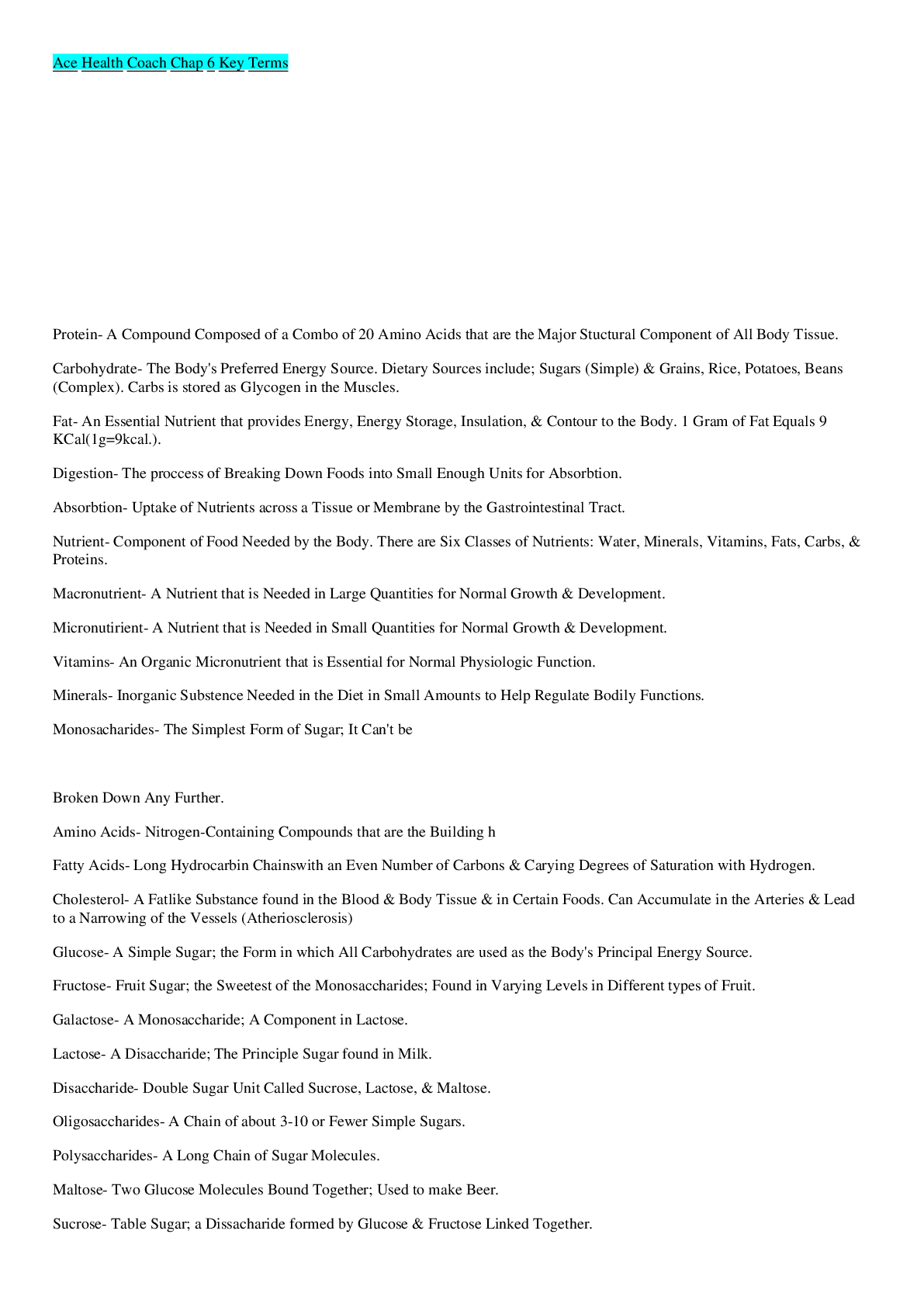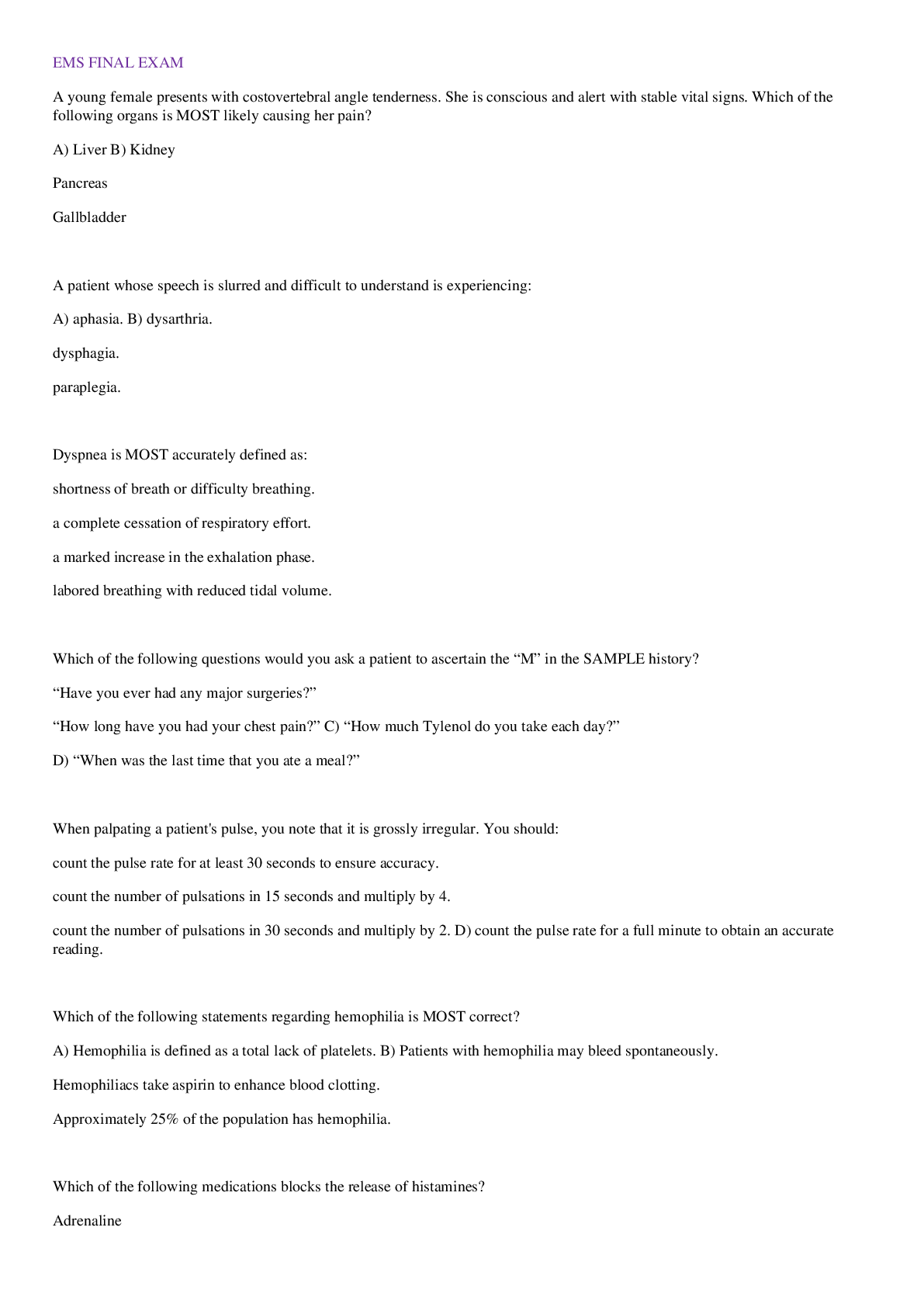Ace Health Coach Chap 6 Key Terms 2022
Document Content and Description Below
1. Protein- A Compound Composed of a Combo of 20 Amino Acids that are the Major Stuctural Component of All Body Tissue. 2. Carbohydrate- The Body's Preferred Energy Source. Dietary Sources include; S... ugars (Simple) & Grains, Rice, Potatoes, Beans (Complex). Carbs is stored as Glycogen in the Muscles. 3. Fat- An Essential Nutrient that provides Energy, Energy Storage, Insulation, & Contour to the Body. 1 Gram of Fat Equals 9 KCal(1g=9kcal.). 4. Digestion- The proccess of Breaking Down Foods into Small Enough Units for Absorbtion. 5. Absorbtion- Uptake of Nutrients across a Tissue or Membrane by the Gastrointestinal Tract. 6. Nutrient- Component of Food Needed by the Body. There are Six Classes of Nutrients: Water, Minerals, Vitamins, Fats, Carbs, & Proteins. 7. Macronutrient- A Nutrient that is Needed in Large Quantities for Normal Growth & Development. 8. Micronutirient- A Nutrient that is Needed in Small Quantities for Normal Growth & Development. 9. Vitamins- An Organic Micronutrient that is Essential for Normal Physiologic Function. 10. Minerals- Inorganic Substence Needed in the Diet in Small Amounts to Help Regulate Bodily Functions. 11. Monosacharides- The Simplest Form of Sugar; It Can't be Broken Down Any Further. 12. Amino Acids- Nitrogen-Containing Compounds that are the Building h 13. Fatty Acids- Long Hydrocarbin Chainswith an Even Number of Carbons & Carying Degrees of Saturation with Hydrogen. 14. Cholesterol- A Fatlike Substance found in the Blood & Body Tissue & in Certain Foods. Can Accumulate in the Arteries & Lead to a Narrowing of the Vessels (Atheriosclerosis) 15. Glucose- A Simple Sugar; the Form in which All Carbohydrates are used as the Body's Principal Energy Source. 16. Fructose- Fruit Sugar; the Sweetest of the Monosaccharides; Found in Varying Levels in Different types of Fruit. 17. Galactose- A Monosaccharide; A Component in Lactose. 18. Lactose- A Disaccharide; The Principle Sugar found in Milk. 19. Disaccharide- Double Sugar Unit Called Sucrose, Lactose, & Maltose. 20. Oligosaccharides- A Chain of about 3-10 or Fewer Simple Sugars. 21. Polysaccharides- A Long Chain of Sugar Molecules. 22. Maltose- Two Glucose Molecules Bound Together; Used to make Beer. 23. Sucrose- Table Sugar; a Dissacharide formed by Glucose & Fructose Linked Together. 24. Enzyme- Proteins that Speed Up a Specific Chemical Reaction. 25. Fructooligosaccharides- A Category of Oligasaccharides that are Mostly Indigestable, May help to Relieve Constipation, Improve Triglyceride Levels, & Decrease production of Foul- Smelling Digestive Products 26. Triglyceride- Three Fatty Acids Joined to a Glycerol (Carbon & Hydrogen Structure) Backbone; How Fat is Stored in the Body. 27. Glycogen- The Chief Carbohydrate Storage Material; Formed by the Liver & Stored in the Liver & Muscle. 28. Starch- A Plant Carb Found in Grains & Vegetables. 29. Complex Carbohydrate- A Long Chain of Sugar that takes more time to Digest than a Simple Carb. 30. Simple Carbohydrate- Short Chains of Sugar that are Rapidly Digested. 31. Glycemic Index (GI)- A Ranking of Carbs on a Scale from 0- 100 according to the Extent to which the Raise Blood Sugar Levels. 32. Large Intestines- A Component of the Digestive System where certain Minerals & a Large Amount of Water are Reabsorbed into the Blood. 33. Dietary Fiber- Fiber Obtain Naturally from Plants Foods. 34. Functional Fiber- Fiber Obtained in the Diet from Isolated Fibers Added to Food Products. 35. High-Viscosity Fibe [Show More]
Last updated: 2 years ago
Preview 1 out of 6 pages

Buy this document to get the full access instantly
Instant Download Access after purchase
Buy NowInstant download
We Accept:

Reviews( 0 )
$10.00
Can't find what you want? Try our AI powered Search
Document information
Connected school, study & course
About the document
Uploaded On
Oct 08, 2022
Number of pages
6
Written in
Additional information
This document has been written for:
Uploaded
Oct 08, 2022
Downloads
0
Views
62














